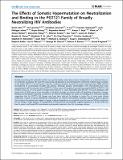The Effects of Somatic Hypermutation on Neutralization and Binding in the PGT121 Family of Broadly Neutralizing HIV Antibodies
Author(s)
Sok, Devin; Laserson, Uri; Laserson, Jonathan; Liu, Yi; Vigneault, Francois; Julien, Jean-Philippe; Briney, Bryan; Ramos, Alejandra; Saye, Karen F.; Le, Khoa; Mahan, Alison E.; Wang, Shenshen; Kardar, Mehran; Yaari, Gur; Walker, Laura M.; Simen, Birgitte B.; St. John, Elizabeth P.; Chan-Hui, Po-Ying; Swiderek, Kristine; Kleinstein, Stephen H.; Alter, Galit; Seaman, Michael S.; Koller, Daphne; Wilson, Ian A.; Burton, Dennis R.; Poignard, Pascal; Chakraborty, Arup K; Church, George M; ... Show more Show less
DownloadSok-2013-The Effects of Somat.pdf (3.058Mb)
PUBLISHER_CC
Publisher with Creative Commons License
Creative Commons Attribution
Terms of use
Metadata
Show full item recordAbstract
Broadly neutralizing HIV antibodies (bnAbs) are typically highly somatically mutated, raising doubts as to whether they can be elicited by vaccination. We used 454 sequencing and designed a novel phylogenetic method to model lineage evolution of the bnAbs PGT121–134 and found a positive correlation between the level of somatic hypermutation (SHM) and the development of neutralization breadth and potency. Strikingly, putative intermediates were characterized that show approximately half the mutation level of PGT121–134 but were still capable of neutralizing roughly 40–80% of PGT121–134 sensitive viruses in a 74-virus panel at median titers between 15- and 3-fold higher than PGT121–134. Such antibodies with lower levels of SHM may be more amenable to elicitation through vaccination while still providing noteworthy coverage. Binding characterization indicated a preference of inferred intermediates for native Env binding over monomeric gp120, suggesting that the PGT121–134 lineage may have been selected for binding to native Env at some point during maturation. Analysis of glycan-dependent neutralization for inferred intermediates identified additional adjacent glycans that comprise the epitope and suggests changes in glycan dependency or recognition over the course of affinity maturation for this lineage. Finally, patterns of neutralization of inferred bnAb intermediates suggest hypotheses as to how SHM may lead to potent and broad HIV neutralization and provide important clues for immunogen design.
Date issued
2013-11Department
Massachusetts Institute of Technology. Institute for Medical Engineering & Science; Harvard University--MIT Division of Health Sciences and Technology; Massachusetts Institute of Technology. Department of Chemical Engineering; Massachusetts Institute of Technology. Department of Mathematics; Massachusetts Institute of Technology. Department of PhysicsJournal
PLoS Pathogens
Publisher
Public Library of Science
Citation
Sok, Devin, Uri Laserson, Jonathan Laserson, Yi Liu, Francois Vigneault, Jean-Philippe Julien, Bryan Briney, et al. “The Effects of Somatic Hypermutation on Neutralization and Binding in the PGT121 Family of Broadly Neutralizing HIV Antibodies.” Edited by Alexandra Trkola. PLoS Pathogens 9, no. 11 (November 21, 2013): e1003754.
Version: Final published version
ISSN
1553-7374
1553-7366